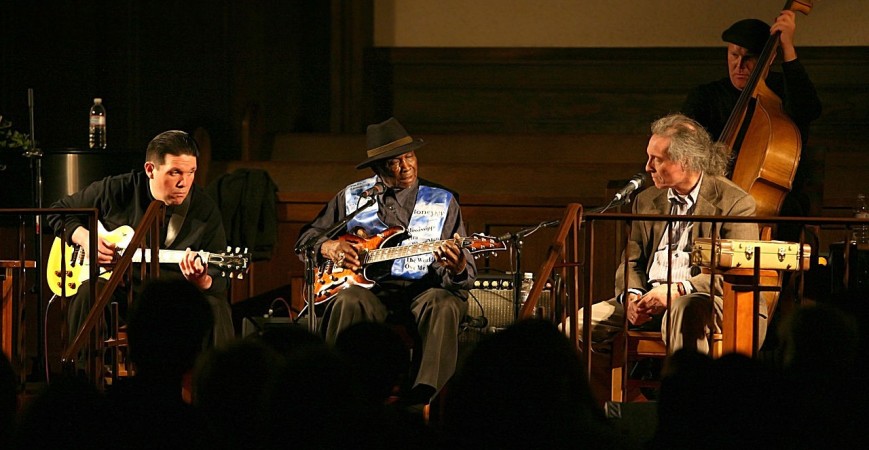Different types of blues
The blues are a state of mind that manifests itself in many ways. If we think about the vastness of his native country (the United States of America) and the different geographies and communities that he is home to, it is easy to understand the diversity of influences and the evolution of different types of blues. Add in globalization and you have the English invasion blues of the 1960s. But whether you come from the Mississippi Delta or elsewhere, the feeling is the same.
Let's get to know some types of blues from a geographical perspective, and see how different cities and regions, by the communities and times in which they gave life to the blues, also gave new ways to interpret them.
Memphis Blues
Memphis is one of the most musical cities on the planet. Located in the heart of the state of Tennessee, it is also the birthplace of rock and roll, and the Sun Records studios, where Johnny Cash, Jerry Lee Lewis, Carl Perkins and Elvis Presley recorded.
The blues emerged in the Memphis music scene in the early 20th century by WC Handy, who incorporated motifs from this traditional style into his band's compositions, giving an urban touch to a style that was predominantly rural.
Many musicians moved to the city in the following decades to play and record the blues in the various studios and concert halls of Memphis, in a crossroads of styles and influences that dynamized and helped to popularize this musical genre. Among them were Tommy Johnson, Mississippi John Hurt, Robert Wilkins, Jim Jackson, Joe McCoy, Gus Cannon, and Memphis Minnie.
The explosion of the blues scene in Memphis takes place, however, after the Second World War, when electric guitars and names like B.B. King and Ike Turner appear.
Vejam Guitarras Elétricas no Salão Musical
Zydeco Blues
The influence of Creole music of French colonial origin is very important in the southwestern United States, and it also had an impact on the blues. Creole sounds mixed with blues, local folk and gospel, giving a unique style: Zydeco.
Incorporating instruments commonly seen in styles such as Cajun music, originating in the same area, Zydeco has a different sound and balance, as you can see in this video of one of its greatest representatives, accordionist Clifton Chenier.
Vejam Acordeões no Salão Musical
Delta Blues
The blues was born in the Mississippi Delta, where it was played by people with no future on an acoustic guitar, sometimes using a slide, and accompanied by a harmonica, to express the lamentations of a difficult life.
The biggest name in the Delta blues is Robert Johnson who, more than a musician, is a legend in the history of modern music. Others are Son House, Muddy Waters, Charley Patton, Lead Belly, Sonny Terry, Brownie McGhee, RL Burnside, an endless list of musicians who have had more weight in 20th century music than they could ever have imagined.
Deceptively simple, this is one of the most popular styles of blues, as it is perhaps the one that sounds the most heartfelt and pure: an acoustic instrument and a voice. It is also the slowest, in a tune more pleasant for suffering souls.
Vejam Guitarras Acústicas e Harmónicas no Salão Musical
West Coast Blues
Leaving Texas for the sunny West Coast, the blues took root in these bands in the 1940s. The West Coast blues is based on solo pianos and electric guitars, driven by more upbeat and energetic rhythms. It will not be surprising that one of its main names is a guitarist, T-Bone Walker.
More refined and electrified than its folk version, was the formation and style of musicians such as Percy Mayfield, Etta James, Roy Milton, Johnny Otis, Johnny “Guitar” Watson and Ike & Tina Turner.
Chicago Blues
A massive south-north migration after World War II brought the blues to Chicago, where they gained electricity and urbanity. Played louder, faster, and with amplified instruments, Chicago blues is a genre in its own right that influenced English musicians in the 1960s and helped define rock'n'roll.
One of the biggest contributors to the growth in popularity of the Chicago blues was Chuck Berry, but also Muddy Waters and B.B.King. The best is to watch the documentary.
Vejam Amplificadores de guitarra elétrica no Salão Musical
Detroit Blues
In Detroit, the phenomenon is similar to that of Chicago, but already with the influence of the amplified blues of the city of Illinois. With the arrival of musicians from the south to work in the factories of Motor City - another name given to Detroit - came their acoustic instruments, which quickly had to be electrified and played at a faster pace to combat the cold of the state of Michigan.
John Lee Hooker had already heard the sound of Chicago and incorporated it into his unique interpretation of the blues, which combines the pure sound of the south with the electric tones of the industrialized north.
Vejam Baixos Elétricos no Salão Musical
New Orleans Blues
One of the most unique and eclectic styles of North American blues is the New Orleans blues. Often known as the original capital of Jazz, New Orleans is a melting pot of influences, from European to Caribbean, that influenced the blues more than we realize. The 12-bar blues was already played there even before it was the accepted model.
New Orleans blues is like the city: diverse, colorful and lively, often played on the piano. And one of the great examples and interpreters of this regional version is Professor Longhair.
Vejam Pianos no Salão Musical
What kind of blues do you prefer? Whatever it is, play it with the best instruments, which you can find in our online store.

